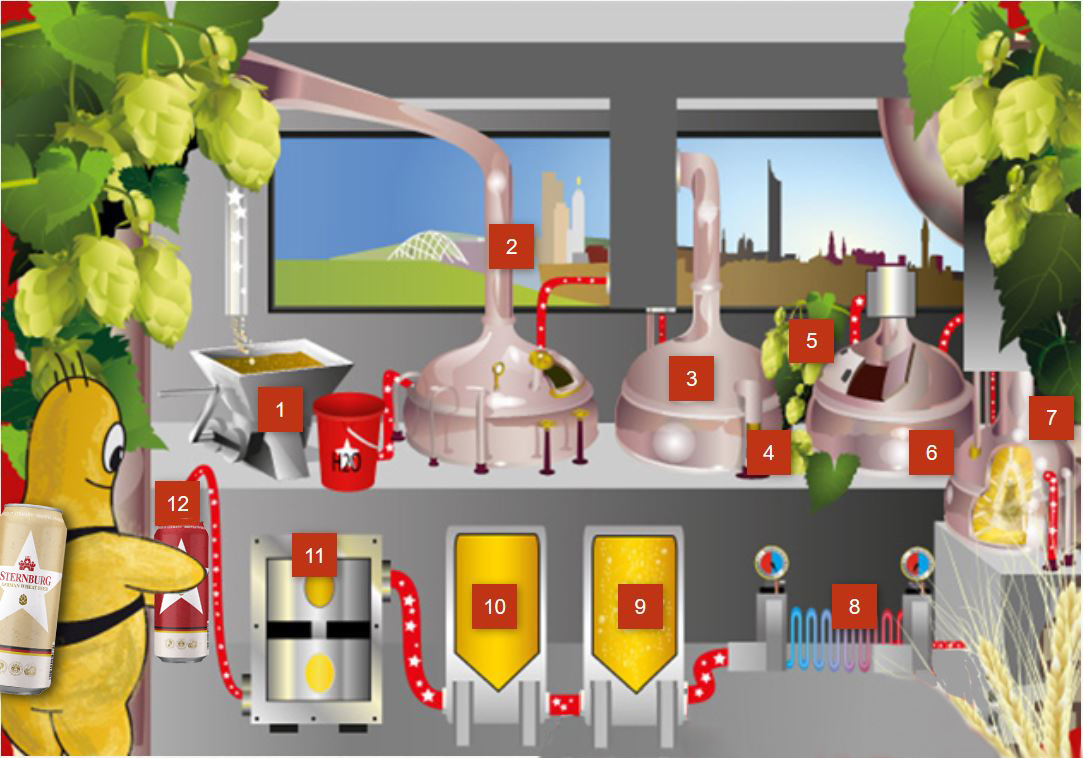Brewing Process
How our traditional German Sternburg beer is made out of hops, water and malt.

1. The Malt
In the malthouse, the foundation for the color and flavor of our beer is created. Here, we select the right types of grain, clean them and soak them in water. The grain begins to germinate, releasing the insoluble starch from within the kernels. This green malt is then kilned – which means dried. Depending on the kiln temperature, we produce lighter or darker malts. The malted grains are stored in silos until they are ready to be processed in the grist mill. This marks the very beginning of the brewing process: in the mill, we crush and grind the malt, preparing it for the next steps that follow.
2. The Mash Tun
In the brewhouse, the crushed malt is now combined with brewing water – and just like that, we have mash! In the mash tun, the mixture is gradually heated to specific temperature levels. This activates the malt’s natural enzymes, converting the grain’s insoluble starch into fermentable malt sugar. All the essential brewing components of the malt dissolve into the liquid.
3. The Lauter Vessel
In the lauter tun, the solid parts of the mash are separated from the liquid. The husks of the malt grains settle on a filter screen – remaining an important part of the wort throughout the process.
4. The Spent Grain
This byproduct, known as spent grain, results from the brewing process. However, it serves as a high-quality, nutrient-rich, and completely natural animal feed used by many local farms in the region.
5. Hops
We owe our distinctive aroma to hops. This “green gold“ gives our beer its characteristic bitterness and a rich, lasting head of foam. Hops also act as a natural preservative and lend the beer a mild, soothing effect.
6. The Brew Kettle
The amount of hops used is essential to shape the final taste of the beer. In the brew kettle, the wort is combined with hops and boiled. The more hops added (100 to 400 grams per hectoliter), the more intense the resulting flavor of the beer.
7. The Whirlpool
In the whirlpool, precipitated malt proteins and remaining haze particles are removed from the wort by means of a controlled circular flow. This process ensures clarity and purity in the final product.
8. The Wort Cooler
Things are getting cold now: In the wort cooler, the temperature drops from around 100 °C (the temperature corresponds to 212 °F) to between 8 °C (46 °F) and 15 °C (59 °F). Only then is the yeast added.
9. The Fermentation Tank
This is where the yeast begins its essential role in the brewing process. Once added to the fermentation tank, it initiates the fermentation process. During this stage, the dissolved malt sugars are converted into alcohol and carbon dioxide – and key flavor compounds begin to develop. We distinguish between top-fermenting and bottom-fermenting yeast strains (both belonging to the family of Saccharomyces fungi). Top-fermenting yeast rises to the surface during fermentation, while bottom-fermenting yeast settles at the bottom of the vessel. As yeast multiplies during fermentation, a surplus forms. This excess yeast is removed – and the young beer is ready.
10. The Maturation Tank
To fully develop its flavor, the young beer continues to ferment slowly in the maturation tanks for around three weeks. Only then is it ready to be enjoyed.
11. The Beer Filter
Before packaging, the beer passes through a fine filter, which gives it a crystal-clear appearance and extends its shelf life. Haze particles and residual yeast cells are removed – making the beer not only taste great but also look more refined.
12. The Finished Beer
Once filtered, the fresh beer finally reaches its new home: It makes its way smoothly through the bottling line and is transferred into the cans. From there it is ready to be enjoyed – at home, in the park, or wherever good moments are shared.
